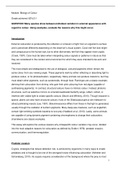Module: Biology of Colour
Grade achieved: 62%/2:1
QUESTION: Many species show between-individual variation in external appearance with
regard to colour. Using examples, evaluate the reasons why this might occur.
Introduction
External colouration is produced by the reflection or emission of light from an organism’s surface
and is perceived differently depending on the observer’s visual system. Coral reef fish look bright
and conspicuous to the human eye, but to other dichromatic reef fish they appear more cryptic
(Crook, 1997). Care must be taken when interpreting colour signals or patterns in nature so that
they are considered in the context and environment for which they were intended to be sent and
received.
The most simple and widespread is the use of biological, coloured pigments which remain the
same colour from any viewing angle. These pigments work by either reflecting or absorbing light to
produce colour, or for photoactivation, respectively. Many animals can produce melanin’s, but they
must obtain other pigments, such as carotenoids, through food. Flamingos are a classic example,
deriving their colouration from shrimp, who gain their pink colouring from red algae (capable of
synthesising pigments). In contrast, structural colours have no intrinsic colour. Instead, photonic
structures, such as selective mirrors on emerald swallowtail butterfly wings, reflect, refract, or
interfere with visible light to create specific colours (Glover and Whitney, 2010). Though research is
sparse, plants can also have structural colours; fruits of the Elaeocarpus genus are iridescent to
attract pollinating insects (Lee, 1991). Bioluminescence differs from these in that light is generated,
usually through the oxidation of luciferin pigments. Many deep-sea creatures, such as anglerfish,
contain light-emitting symbiotic bacteria to lure prey (Haddock et al., 2010). Lastly, some animals
are capable of using dynamic pigment-containing chromophores to change their colouration;
chameleons are classic examples.
This essay will explore the various reasons why intraspecific colour variation may occur, divided
into the main adaptive reasons for colouration as defined by Endler (1978): predator evasion,
communication, and thermoregulation.
Predator evasion
Crypsis, strategies that reduce detection risk, is achieved by organisms in many ways to evade
predators and is thought to be one of the strongest forces influencing colouration (Hofreiter and
Schoneberg, 2010). As crypsis requires consideration of the background where the prey is most
1
, vulnerable, and the predator’s perception of that background (Endler 1978), species with wide
spatial distributions, and hence varied predators, often differ in colour. Many use background
matching (BM) to match their appearance to their specific background type (specialist) or to
several background types (compromise). BM variation typically arises from genetic polymorphisms,
however it may arise from obtaining pigments through differing food sources. Great tit nestlings in
deciduous forests were fed more yellow pigment-containing larvae than those living in coniferous
forests, so were tuned to match their background (Slagsvold and Lifjeld, 2009).
Individuals may change their colouration for better BM, morphologically by altering the number and
quality of epidermal chromophores (days to months), or physiologically by moving pigment
granules within chromophores (seconds to hours) (Stuart-Fox and Moussalli, 2008). Many
poikilotherms show rapid colour change, including dwarf chameleons who alter their arrangement
of iridophores to match their background. Chameleons show a stronger BM response when in
proximity to bird rather than snake predators as birds have greater colour resolution, suggesting
they adapt their response to the predators’ sensory capabilities (Stuart-Fox et al., 2008). Thus,
colour changing conspecifics frequently show colour variation. Similarly, Bornean gliding lizards
match their colouration and movement to mimic the most common falling leaves in their specific
habitat (Klomp et al., 2014).
Masquerade is a form of crypsis in which organisms resemble an inanimate object from their
environment to facilitate misidentification. Masquerade is more effective when the organism is
mimicking a common object in the environment; emerald moth larvae born in spring will resemble
oak catkins, but those born in summer instead resemble the twigs that catkins developed into
(Greene, 1989). Varying the type of masquerade like this allows for better predator evasion, and
therefore is commonly observed in vulnerable juveniles. In marine organisms, juveniles are often
transparent to minimise detection by bioluminescent predators. Juveniles may also differ in
colouration if they differ in fitness; smaller juvenile banana weevils were significantly more likely to
have striped disruptive patterning than larger juveniles (Crook, 1997). This confers an anti-predator
advantage through difficulty of interception.
Communication
In contrast to crypsis, animals use conspicuous colouration to signal to receivers. Aposematic
warning colours are often used to advertise distastefulness to potential predators, who may vary in
visual capabilities and between populations. Conspecifics may differ in colour temporarily, for
example cuttlefish exhibit deimatic displays of bright eyespots when approached by visual
predators, but not chemosensory ones (Langridge et al., 2007). Alternatively, colour
polymorphisms may arise when individuals mimic the rarest noxious heterospecifics (Batesian
mimicry) in their specific region to share in predator avoidance. Mimicking the rarest species allows
2




